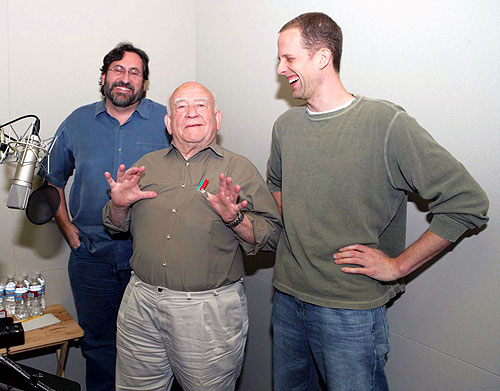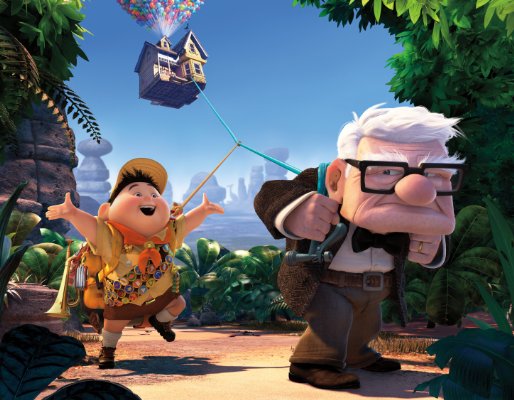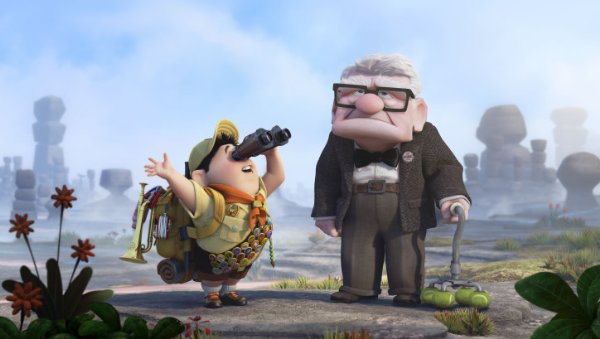When
Pete Docter,
director of the Oscar-nominated animated film
Up, was coming to New
York City to accept an award, I got an e-mail letting me know about
it: "Would you like to interview him?" Hell, yeah! Though this year
has been great for animated films, with
Fantastic Mr. Fox and
Coraline
providing innovations in stop-motion, and Disney doing a bouncy
return to traditional animation,
Up provided the ideal
blend of a child's sense of wonder and a snarly, craggy version of
adult power struggles. As a result it got nominated, but not for
Best Animated Feature — it's among the nominees for Best Picture!
The
feature-length film tells of the young Carl Fredrickson, who
idolizes the international renowned adventurer Charles Muntz.
Through this worship meets a similarly spirited young girl Ellie and
they become friends. When Muntz falls from grace, accused of faking
his great find – the skeleton of the Paradise Falls monster – Muntz
travels to South America in a blimp, supposed to prove the beast was
alive but is never seen again. Eventually Carl and Ellie grow up and
marry. Though they promise to travel together to that lost land and
build a house there, distractions set in and 70 years later, Ellie
dies. The lonely, grieving, childless Carl (now voiced by Ed Asner)
refuses to move from the house they shared despite generous offers
from a construction company that wants to tear it down. When Carl
accidentally hits a worker who damaged his mailbox, he is forced to
move to a retirement home. He decides to fulfill his promise to
Ellie, and uses a plethora of balloons to float the house away in
order to travel to Paradise Falls. However he has a stowaway.
Eight-year-old Russell – who is trying to get his merit badge
assisting the elderly – is hidden aboard. The two escape and travel
to strange lands where they meet talking dogs, the now-crazed Muntz
and a rare bird named Kevin.
Docter, the
41-year-old
Bloomington,
Minnesota
native, has been at
Pixar
Animation Studios for 20 years, working on the story
and as head of animation for the groundbreaking CGI feature
Toy Story (1995). He
went on to help craft the story for the 1999 sequel; to direct
Monsters, Inc. (2001); and to co-write the story for
WALL-E (2008).
Docter's been nominated for three
Academy
Awards, and has twice won the animation
field's top honor, the
Annie Award.
Meeting Docter
and his producer
Jonas Rivera
offered one of those rare moments — shall we say an
Up moment — to
discuss in some detail his long career in a unique medium at a
unique time in its history, a time that bodes well for both
narrative and technological innovations.
Where did this story begin?
This story was a little odd. With
Monsters, Inc., I
remember being in the shower and thinking, “Say, we could do
something with monsters that live in the closet and scare kids” and
“why did they do that. It’s either entertainment for them or it’s
the job for some.” It all extrapolated out from that concept. This
one came from basically the idea of getting away from everything.
The way I would explain it was everybody has a point at which they
just feel like the world is too much, I just want to escape from
everywhere and everybody. That’s what kind of started the movie. Of
course it evolved and developed beyond that, and it doesn’t really
have that much to do with getting away from the world. It’s more of
a connection to his wife, which develops maybe six months into the
story workings.
 It's
a curious storytelling process here. You have one idea and you take
it along one path with the Ed Asner character and his wife. Then you
add in the little kid and all he’s dealing with. Then you bring
these two elements together. Then the house launches. You played out
this one path, then you throw in something else, and somehow they
integrate. It’s amazing how that works.
It's
a curious storytelling process here. You have one idea and you take
it along one path with the Ed Asner character and his wife. Then you
add in the little kid and all he’s dealing with. Then you bring
these two elements together. Then the house launches. You played out
this one path, then you throw in something else, and somehow they
integrate. It’s amazing how that works.
That’s the tricky part for sure. We started with the house flying
and then we worked backwards to figure out; who is this guy? Where
is he going? Why is he flying a house as opposed to just taking an
airplane like a normal guy? And why specifically this place? We
really tried to think through logically and emotionally – sometimes
those are at odds and sometimes they’re going the same way – what is
it about all these elements that work towards the central theme of
the film? Really what happens in the first couple of months when you
look back, a lot of the key elements are established very quickly,
but you don’t really know because there’s a bunch of other things
that get thrown out and other things that get added in. From there
it’s just a matter of working those pieces and massaging them so
they all work together.
How did it get written, evolve and how did you decide the twists and
turns?
It started
from a drawing.
Bob Peterson
and I — Bob being the co-writer and co-director — we just sat in a
room and thought of ideas we’d love to play around with. An old man,
especially a grouchy old man with a lot of attitude and passion, you
know where he’s coming from. He’s going to state his opinion whether
it’s popular or not, just like my grandfather. That just seemed like
a great place to start for a character. A lot of times we end up –
and a lot of people do – with this sort of bland protagonist disease
where the lead character is just this milquetoast guy; you don’t
want to do anything too nasty because it will turn the audience off
or something. With Carl you could sort of get away with a certain
amount of attitude because you give him leeway; he’s an old man,
he’s allowed to be grouchy. So we played with that. The other thing
that contributed heavily was the house floating away. That really
went back to some feeling that I think everybody has, but I
certainly did directing
Monsters, Inc.;
directing is such an interactive, people-centric thing, and by the
end of the day I’m an introvert.
I’d want to go crawl under my desk and just hide and rock by myself for
a little while, so floating away from everything just seemed
appealing. So we combined those and worked backwards and forward as
to why is this guy going? Where is he going? Answering those
questions.
Where the hell did you come up with the talking dog?
Actually the question really is how do you buy into the story?
Because anybody can come up with these weird ideas, and the
beginning versions of this story were a little bit of a grab bag of
cool things that we just thought would be fun. They were, but the
difficulty in making these stories is connecting them all; weaving
those threads together so that this is a story that makes sense to
have talking dogs. Hopefully we did that and you’re sort of brought
in by Muntz, who’s kind of the opposite of Carl. So this is the
logic: Carl never actually got to go on this real adventure, to
travel to exotic places and see amazing things. His adventure was
relationship. Muntz was the opposite: He went to the ends of the
earth but he never actually had any relationship except for this
weird, twisted one of himself and his dogs, which also kind of
explains how he’s able to do all the things he's done, et cetera. So
that was our buy-in [to] getting the dogs worked in.
 I
also think what makes it convincing all the way around is your
casting of the voices. This is really a movie about these people
living through these characters.
I
also think what makes it convincing all the way around is your
casting of the voices. This is really a movie about these people
living through these characters.
Of course,
when we cast the film we'd already designed the characters.
And you never had actors in mind as you were designing them?
Well, we had a
bunch of actors in mind. With this one, of course,
Ed Asner
rose to the
top of the list pretty quickly. But then what happens is when we
cast we start to be informed by the actor. So the writing of the
character changes, the way in which they speak, the words they use,
that all changes, and we try to basically write to the strength of
the actor.
That certainly
was the case of the kid. His name was
Jordan Nagai.
He’s not an actor, never done stuff before. What most animation does
is they get an older woman who is an actor, who can kind of sound
like a kid, like with [Nancy
Cartwright's voicing
of]
Bart Simpson.
But we really wanted to have that authenticity here and so we found
this kid who just sounded very sweet and real and truthful. We
rewrote the part; it was originally a little more hyper and
bouncing-off-the-walls, and Jordan is a much more reserved kid, so
we adjusted that character and slid it more to play to his
strengths.
Talk about the wife and the little girl, or the little girl becoming
the wife.
The young girl
was my daughter.
I didn't realize that you actually used kids on some voices. To use
kids is really a challenge in an animated film.
I credit the editors, [led by]
Kevin
[Nolting].
I think they're as much to credit for these performances as some of
these actors, because a lot of times what happens – not in the case
of Plummer or Asner, of course, this is more when you’re working
with kids – but a lot of times you get just these little snippets
where right there for three words they sounded believable and then
they went off the rails, but then this other track here, if we cut
that together…. So it ends up this
Frankenstein
mess which sounds seamless and natural, but that's the strength of
the editors.
Christopher Plummer is the perfect guy to play Muntz. Was that
because you saw
The Sound of
Music?
No. Of course I remembered him from that, but there was another
movie where he’s like this rugged adventurer kind of guy. When we
designed the character we were thinking of him a little bit more
like
Ernest
Hemingway;
more gregarious and loud. When we cast Plummer he gained a
little more refinement and education, and just colored that
character a little bit.
 Had
he done animation before this?
Had
he done animation before this?
Quite a bit. In fact, he’s done just about everything. We were
recording and he did something, and the engineer said, “Mr. Plummer,
can you stay closer to the mic? You went off mic a little,” and he
said, “Oh, no, that was on purpose; it was a trick I learned from
Orson Welles in radio. He would move back away to
give a proximity,” and he was right. This guy has done everything;
he knows his craft.
The dog must have been fun to cast.
Dug was
Bob
Peterson, who, of course, wrote the part, but he
said he was channeling a dog that he used to have.
And you didn't say, “Well, we've got to get a real actor?”
Well, with my daughter,
we cast her not because she's a great actor, but because she was
available, and it was the same with Bob. He's just is so funny that
by the time it came to casting we were like, “You know what? We
don’t even really need to look anywhere else because this is just
working great.”
This is a pretty trim voice cast for an animated film.
That was by design, too. You're making a point of the strength of
the performance by the actor. The other thing that kind of is
invisible to the audience is the strength of the animation. When you
really look at it this film doesn't have a ton of dialog compared to
a lot of films. These animators are so talented and they've built up
their skills on over ten films now.
I
think the dog had more dialogue than a lot of the other characters.
Carl is a man of few words.
Do you have your own favorite moments in
Up?
Yeah, I do. My favorite is probably the sequence in the beginning we
called “Married Life.” It is four-and-a-half minutes of their life
together. That was a lot of fun to do but kind of nerve-wracking,
too, because you have to be careful when you're presenting something
like that that you don't top the schmaltz-o-meter. But it seems to
have succeeded, so I'm very proud of that. There's another scene at
the end where Carl gets finally inside the house, and he sits down
and he goes to look through the adventure book and finds that those
blank pages are full of pictures of the two of them. I'm proud of
that one, too, for much the same reason, where it's the
juxtaposition of the images and Carl's face. Between that and the
acting, that scene I feel like works quite well, and it's all done
without dialogue.
Email
us Let us know what you
think.